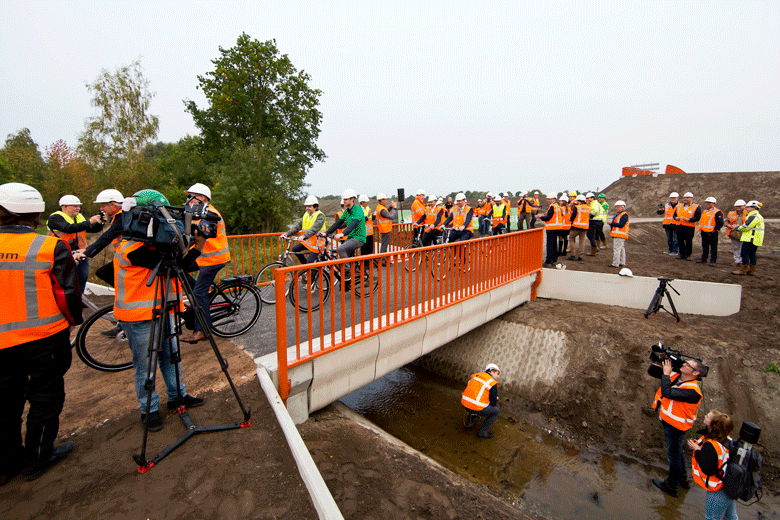

The Netherlands’ University of Eindhoven was working on its programme for 3D printing with concrete when Johan Bolhuis paid a visit. A design manager at contractor BAM Infra, Bolhuis saw huge potential in the 3D-printing programme. By printing elements in a certain pattern, connecting them together and then pre-stressing them, these concrete elements could become a bridge.
The idea was born, but BAM Infra needed an opportunity to put the idea into practice. This was provided by the province of Noord-Brabant on its Gemert Noord-Om project, a new peripheral road scheme connecting the N605 with the N272 roads. This involved construction of a new road, a roundabout, two bridges (one 3D printed) and landscaping of the surroundings. The province awarded the project to BAM Infra because it considered the 3D-printed structure to be innovative and environmentally friendly.
 The body of the 3D-printed part of the bridge is 6 m long, made from six 1m-long blocks. Each has the same pattern consisting of an element with hollow spaces, instead of a dense concrete block, resulting in a massive concrete saving of as much as 40 per cent. The elements were built up in printed layers of concrete each about 10cm wide and 1cm high. During printing, a two millimetre-diameter metal reinforcement wire was added to each layer using a specially manufactured feeder placed alongside the concrete nozzle. The blocks were printed vertically and when complete measure 1m x 0.6m x 4m
The body of the 3D-printed part of the bridge is 6 m long, made from six 1m-long blocks. Each has the same pattern consisting of an element with hollow spaces, instead of a dense concrete block, resulting in a massive concrete saving of as much as 40 per cent. The elements were built up in printed layers of concrete each about 10cm wide and 1cm high. During printing, a two millimetre-diameter metal reinforcement wire was added to each layer using a specially manufactured feeder placed alongside the concrete nozzle. The blocks were printed vertically and when complete measure 1m x 0.6m x 4m
Material strength
After constructing the six elements, the blocks were rotated 90 degrees and connected with an epoxy. They were then pre-stressed between two traditionally manufactured concrete blocks. Dimensions of the blocks were calculated based on the required strength for the bridge and the restrictions of the printer. Based on tests, it was shown that the calculations were accurate and the blocks did not require any formwork to maintain their structure during printing.
The concrete mix is a development from Weber Beamix Saint Gobaint together with the Eindhoven University of Technology. The mix is designed in a way that it stays fluid while it is pumped. When the pumping is stopped, the material starts to harden. In beginning of the project, the university had never printed higher than 20cm. Another obstacle that had to be overcome was the fact that two pumps were needed to print one element. BAM Infra notes that lots of technical issues were solved by working together as a team.
[caption id="attachment_326946" align="aligncenter" width="780"] Concrete is printed in 1cm-high, 10cm-wide layers with wire reinforcement added at the nozzle. [/caption]
Concrete is printed in 1cm-high, 10cm-wide layers with wire reinforcement added at the nozzle. [/caption]
Importantly, the team learned that the way the bridge was produced was very different to the conventional way of building a bridge. The design needed to be exactly right because this was converted to a print-path and that created the structure that was produced and there was no potential for making onsite adjustments.
The design life of the bridge is 50 years, and the team notes it saved 40 per cent in terms of construction material, which also reduces the carbon footprint of the bridge. The exact replication of the design into the 3D printer also minimises failure cost and accelerates the speed of building, all of which is better for the environment.
The world’s first 3D-printed bridge was completed in October 2017.
This article was originally published in MEED Mashreq Construction Report Vol 3: Delivering Innovation in Construction, in April 2018.

This article is extracted from a report produced by MEED and Mashreq titled Delivering Innovation in Construction. Click here to download the report
You might also like...

Iraq signs deal to develop the Akkas gas field
25 April 2024

Emaar appoints beachfront project contractor
25 April 2024

Acwa Power signs $356m Barka extension
25 April 2024

AD Ports secures Angola port concession agreement
25 April 2024
A MEED Subscription...
Subscribe or upgrade your current MEED.com package to support your strategic planning with the MENA region’s best source of business information. Proceed to our online shop below to find out more about the features in each package.




